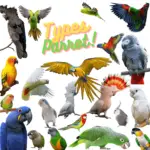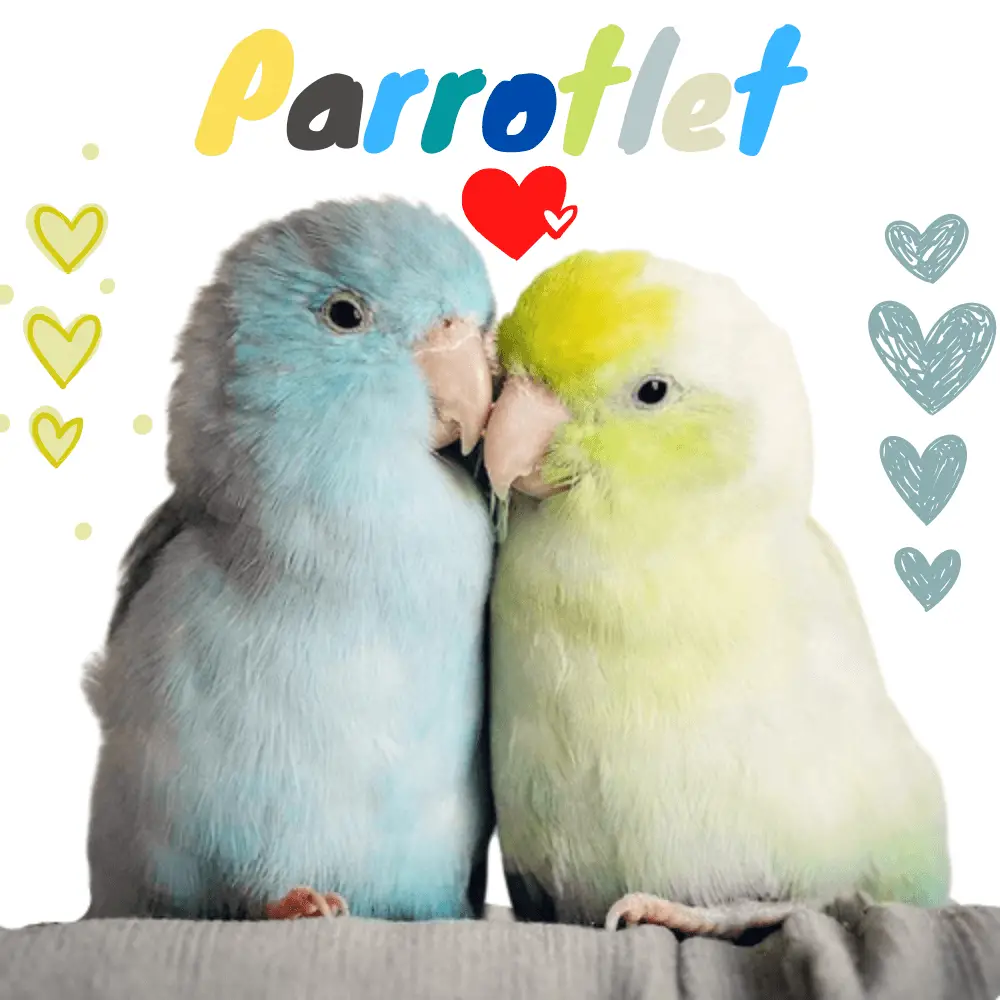
Parrotlet (Forpus coelestis)
-
COLOR: Blue, Green, Yellow
-
SIZE: small
-
LIFESPAN: Up to 20 years
-
SOUNDS: Vocal communicator
-
INTERACTION: Social
| Reign | Animalia |
|---|---|
| Branch | Chordata |
| Sub-embr. | Vertebrata |
| Class | Aves |
| Order | Psittaciformes |
| Family | Psittacidae |
| Kind | Forpus |
Parrotlet Species
IUCN conservation status
LC: Least concern
CITES Status
The Forpus coelestis( Forpus coelestis ) is a species of bird belonging to the family of Psittacidae.
Parrotlet blue
What is a parrotlet
The Parrotlet has various local names. In America, the proper name would be “forpus parrot” indeed it is the smallest parrot in the world.Description
The Celestial parrotlet Forpus coelestis ) has green plumage, as does the Evergreen ( Forpus passerinus ), but there are other man-made mutations, including American yellow and turquoise blue.Parrotlet colors

- Parrotlet Green Pied
- Parrotlet American Yellow
- Parrotlet Green Marbled
- Parrotlet American Yellow Marbled
- Parrotlet American Yellow Fallow
- Parrotlet Blue
- Parrotlet Blue Pied
- Parrotlet American White
- Parrotlet Blue Marbled
- Parrotlet Blue Fallow
- Parrotlet American White Marbled
- Parrotlet Turquoise Pied
- Parrotlet American Turquoise
- Parrotlet Turquoise Marbled
- Parrotlet Turquoise Fallow
- Parrotlet American Turquoise Marbled
- Parrotlet American Turquoise Fallow
- Parrotlet Grey Green
- Parrotlet Grey Turquoise
Nesting
The female lays between 4 and 8 eggs which she incubates for 18 to 20 days. The young leave the nest around the age of 30 days. The father helps the mother to feed the chicks. The young will reach sexual maturity at the age of 1 year. If they mate too early, the female may die of exhaustion.
Longevity
This species can live between 10 and 15 years in captivity.
Parrotlet Care For Beginners | Topics
SOURCE:Flock-Talk
Parrotlet Habitat

Parrotlet Breeding

Parrotlet as pets
As long as separate cages are kept they can fly together outside of their respective homes. Budgies are the more easy-going and accepting, as long as you keep their cages separate there shouldn’t be an issue.Food
The daily food that a parrot eats includes a combination of inseparable elements:
- Extruded or granulated (balanced nutritional intake).
- Seed mixture (vitamins, minerals, and trace elements).
- Sprouted seeds (proteins, vitamins, minerals, enzymes, chlorophyll, and trace elements).
- Fruits and vegetables (provitamin A or beta-carotene).
- Plants and grasses (vitamin A).
- Mineral block or cuttlefish bone (calcium and iodine).
You can also occasionally provide whole, cooked cereals such as wheat, rice, spelled, barley, oats, canary seed, quinoa, millet, corn, rye, and buckwheat.
Parrotlet care
SOURCE:Pinchos the Parrotlet
Sharing experience of the breeding of Parrotlet Celestes
As a preamble it is important to remember that all living things are unique and that each bird has a personality and therefore a behavior of its own, nevertheless, we can try to define general rules that will correspond to the greatest number, but remember that there will always be individual behaviors that will deviate from generalities.
Choice and Preparation of Broodstock
My birds are in large community aviaries outside the breeding period, of course, it is forbidden to have nests or shelters that can be used to nest, otherwise, there is a risk of deadly fighting.
It is prudent to have several food points and one or more water points allowing birds to drink and bathe in what they love to do.
The celestial is a greedy bird so it is necessary to give it a varied diet and insufficient quantity but of course, without excess, the aviary, as the name suggests, must be large enough for them to fly and flee in case of quarrel, which happens. For my part, the aviary is 15 cubic meters for about twenty pairs and has many perches of branches and leaves to amuse the beaks. I am lucky to have a very large laurel sauce that allows me to feed the aviary all year round and in addition, it smells good.

Community Aviary Parrotlet Celeste
Good bird watching makes it possible to guess the characters of each bird which helps in the choice of broodstock.
Parrotlet colors
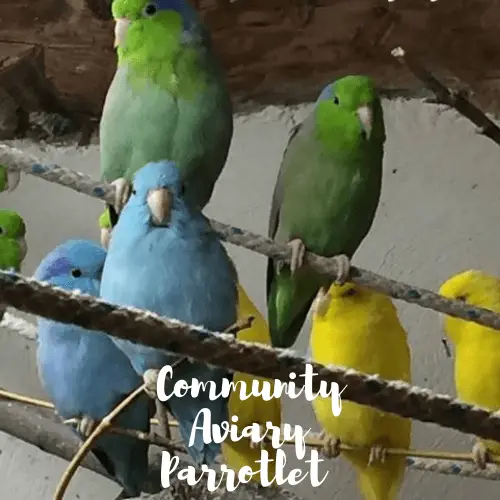
Community Aviary Parrotlet
There are many mutations that help in the formation of couples according to the project of each breeder. It is important to always have birds of wild hue, green, good size, and morphology that will be used to create your own strain and mutation carriers because it will be necessary to constantly go through this wild strain to keep beautiful birds in each mutation.
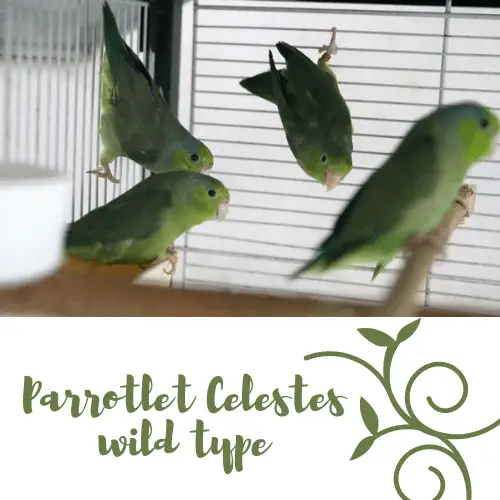
Parrotlet Celestes wild type
The first mutation that we will work on will be blue which will allow declining the whole series of blues and greens by knowing the genotypes of its birds but this is another story that alone can make a lot of ink flow.
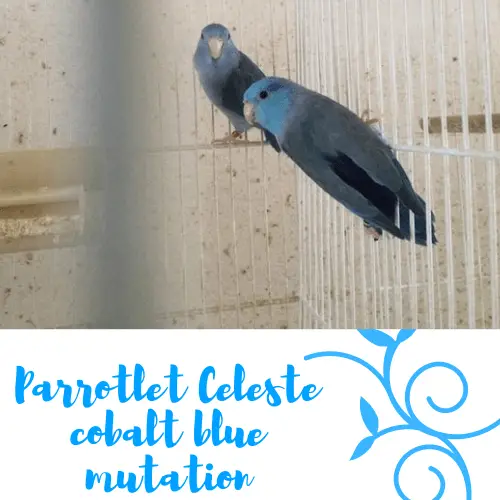
Parrotlet Celeste cobalt blue mutation
We will therefore choose for the breeding season the calmest and most “beautiful” birds in size and shape. It is important to breed birds only from the age of eighteen months although the sexual maturity is eight months and this is to have the best young without exhausting the parents, especially for females, who must not make more than two or even three litters per year.
Reproduction Cage of the Parrotlet
Of course, there is no maximum size but it will be necessary to use a cage at least 60cm long by 50 cm deep and 40cm high, larger is even better, especially for the length.
The bottom of the cage will be kept as clean as possible and practical enough not to disturb the couples too often for cleaning which will be almost impossible during the period of feeding the young at the risk of panicking the parents and in some cases causing the young to fall out of the nest. Steril sand or other absorbent materials.
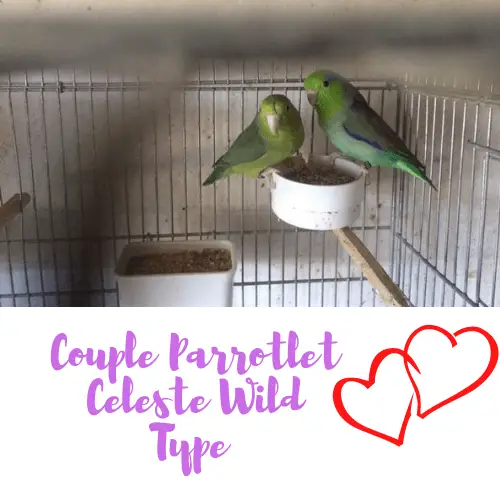
Couple Parrotlet Celeste Wild type
I have the feeders accessible from the outside of the cage, one for the dry seeds, one for the sprouted seeds, one for pâtée large parakeets in which I add grammars and dried mealworms, and finally one with grit. I constantly give fruits and vegetables the basis being apples and carrots. To finish the arrangement a dry bone, a source of calcium and magnesium, and from time to time a branch of millet (red).
Here the cage is ready and still no nest.
Preparation of Parrotlet Celeste
I always start by introducing the male alone for at least a week, females are more territorial than males. He will get used to the new feeders and discover his cage. I have isolated for several weeks all the females in an aviary without males to avoid unwanted ticking and arranged the same food in quality and quantity as for the cages of males.
Formation of Couples, How do you form a Couple of Parrotlet?
Three parameters are fundamental to trigger the reproductive instinct, they are:
- the abundance of food, it is necessary that the little head of the Piaf is told that there is enough for him and for his little ones
- humidity, it is in the wet season that the grasses grow, so I equipped the cages with outdoor bathtubs whose water i change every day
- light, in fact, it is necessary to gradually increase the duration of lighting to arrive at the end of a week at 14 hours of light per day. I tried the “special” lamps without observing better results than with neon daylight, cheaper and more durable since they last all season, I only change it every year. It is desirable to have two light sources for my part the neon on the base and a small lamp that will turn on before and turn off after the big light to avoid suddenly passing from day tonight. I use “timers” bought at the supermarket for a few euros which are more than enough, by setting the ignition of the small lamp just before the main lighting is turned off and its extinction a quarter of an hour after that of the neon.
A week after putting the male in the cage I introduce his promise, still, no nest, the welcome of Madame is sometimes a little manly and it heckles a little but it is not worrying usually everything quickly returns to order, and the couple is forming. It is important to wait for this quiet period to hang the nest outside the cage.
For my part a horizontal nest with two compartments of 25cm and 15 by 15, whose bottom is lined with wood chips that they will keep or not.

Nest for Parrotlet Celeste
From this moment there is only to wait, the male will visit the nest and you will see him feeding the female which are signs of an upcoming laying of eggs. Next or not usually a fortnight and sometimes three months. Patience is the first quality of the breeder.
One day you will find that the female is often in the nest and sometimes does not come out anymore.
The role of the male is essential, a good male feeds the female during brooding provided that the latter accepts that he enters the bridal chamber he sometimes does it only through the flight hole while sometimes he broods with his lady, everything exists.
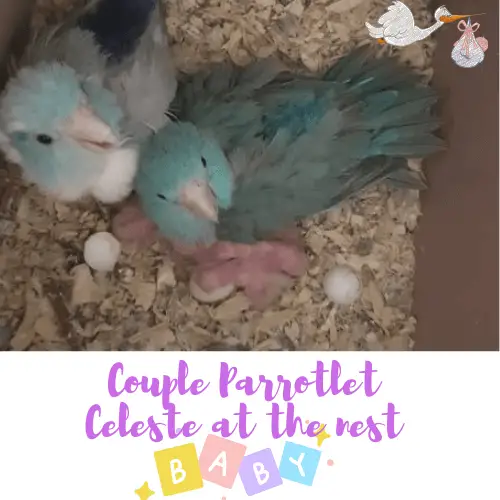
Couple Parrotlet Celeste at the nest
It will be necessary to check the egg-laying by visiting the nest quickly and not too often, moreover it can be inhabited by a tigress who will make you understand that you are not welcome.
The laying is on average four to five eggs, sometimes less sometimes more.
The female usually broods after the laying of the third but sometimes the first will spread the births.
I put the eggs a week after laying the fourth egg, I will do it again a week later. If unfortunately, the eggs are clear I remove everything, which is relatively common when it comes to the first laying of the female and which is not worrying for the rest because she will quickly redo a laying which is often fertilized.
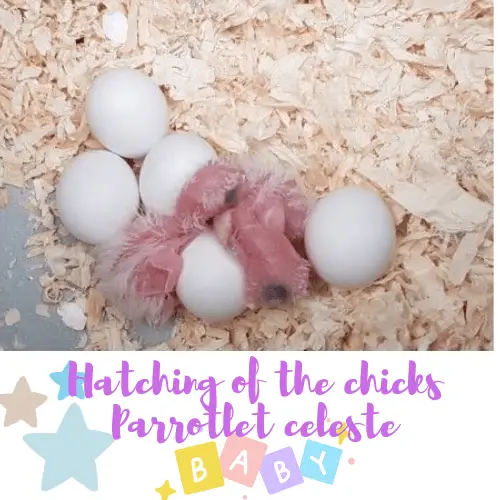
Hatching of the chicks Parrotlet celeste
Hatching will begin about 19 days after the beginning of brooding, I visit the nest around 22 days because if a cub is dead it must be quickly removed. In general, everything goes well. The role of the male is essential he will take care of his brood with the female. The celestial is a good parent who takes care of his young and they usually grow without problems.
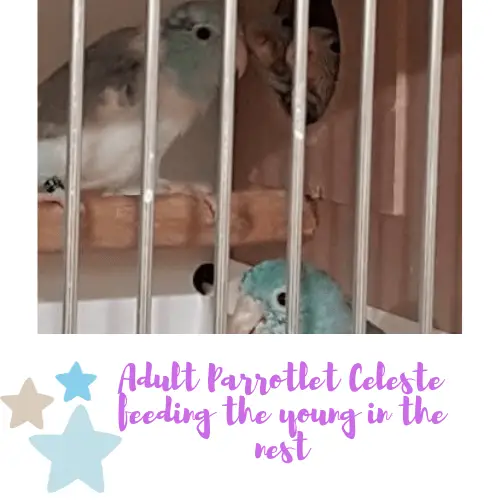
Adult Parrotlet Celeste feeding the young in the nest
From the eighth day we can start banding the little ones, for my part I prefer to lose a ring than to hurt a baby and I start banding very early.
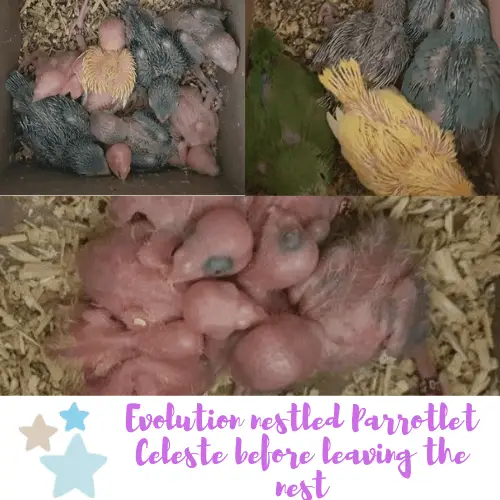
Evolution nestled Parrotlet Celeste before leaving the nest
The rings will be 4.2 millimeters and I note the date of the banding on my breeding notebook that I have fed with information since the formation of the couple.

Young Parrotlet Cobalt Mutation
The young will leave the nest around the age of one month sometimes a little earlier sometimes a little later and will be separated from the parents for around forty days at the risk of seeing the male attack his sons out of jealousy.

Young male Lutino parrotlet 30 days at the exit of the nest

Young 30-day-old blue variegated male ready to come out of the nest

Parrotlet Celeste 30-day Cobalt mutation

Female Parrotlet Wild Type of 30 days
Here it remains for me to wish you good luck and a lot of pleasures, breeding brings a lot.
Do parrotlets like to be held?
Males and females can both be affectionate They form strong bonds with their owners and make excellent pets when properly raised and tamed in captivity, they are often kept as pairs and they may get lonely
Can parrotlets talk?
It can talk! Like most parrots but they have higher-pitched voices that are not as easy to understand, parrotlets can talk, but they are a little less noisy than other parrots.
Are parrotlets good for beginners?
Yes, there are very lively birds with a good sense of humor in Parakeets. affordable and affectionate are some of the parakeet qualities that make them excellent starter parrots for beginners
Are parrotlets aggressive?
No, are not as aggressive as their reputation makes them seem, they will occasionally bite pets and humans

